Hot ski mountaineering becomes a race against the clock
After looking at my watch and feeling the heat of the sun beat down on my hood and hat, I knew we were behind schedule. In spring, the timing of when snow thaws enough to ski but remains safe enough to descend is a game that I play aggressively, sometimes to my own detriment. I’d played it badly that morning, letting my brain bargain those few extra minutes of rest after the alarm rang.
As Manasseh and I climbed the east face of Mount Hood earlier, our skins were velcro to the plush of the quickly thawing snow. They clung to a skin track that cut switchbacks on the 40 degree slope, allowing us to make good time and gain hope. But, when we switched to crampons, my first steps plunged with my aspirations into the lower layers of the warm snow. And as I plodded ahead, staggering knee deep in unsupported steps, I knew we were definitely too late.
Route Beta
Time Round Trip: 5-8 Hours
Total Ascent: 5715
Difficulty: Expert. The chutes from the summit can exceed 50 degrees over cliffs.
Top Elevation: 11,250
Season: May – June
Location: Newton Clark Headwall, Mount Hood, Oregon
GPS: 45.3318° N, 121.6652° W
Weather: Mount Hood Mountain Forecast
During two years I lived in Portland, Oregon almost a decade ago, Mount Hood was a haven above the clouds during dreary Northwest winters. She would sit there, ironically obscured by low hanging ceilings of clouds that would give way to bright sunny days. Hours of driving were rewarded by nearly un-skiable high alpine snow and ice. Summits were rare in the winter, but the big mountain feeling always kept me company. Ski mountaineering was new and motivation was high even on the never ending treadmill of the Palmer snowfield during lonely dawn patrol mornings. The maritime snowpack and wind hammered slopes offered the ability to ski alone in a way the Rocky Mountains never did.
This intense bond of repetitions with this peak has connected me in a way that few mountains in the world will ever rival. I can’t take a ski trip to the Northwest without attempting another summit and one its many skiable faces.
The Newton Clark headwall towers over the glaciers that bear its name on Hood’s east face. When you look at a ski line head-on it often looks steeper than it actually is, but if it looks steep from every other angle, too, it must be so. As we neared the top, we realized just how steep it was, and just how far we had to go.
Before you go to all points on climbing it is nice to take a break, get some food and gather yourself for the final push. All of these luxuries were forsaken for a few extra minutes in bed that morning far below. Instead, we hastily powwowed on a small saddle below the top and I charged ahead.
As we pulled into the last steep pitch just a few hundred feet short of the summit, we surpassed our crucial margin of error. A rocky face with a thin strip of dirty mashed potatoes beckoned us upward, but when we attained the ridge with a steep chossy down climb below and spotted two climbers traversing back to their skis in the saddle beneath us, we realized that this final wrong turn had cost us the summit.
On this bright and hot sunny day, one skier had successfully lugged his skis to the top of the seemingly melted out and but apparently skiable line. He hooted and hollered down a dirty ribbon of snow just out of sight, briefly came into view and disappeared over the steep rollover below. Nervous about the snowpack below, we transitioned fast and gave pursuit.
My first ski cut of the slope sounded like the breaking of so many champagne glasses that I had come to associate with bad timing and bad conditions in the mountains. As I stopped to let the stream of tinkling glass slide by, I searched for confidence that the slope would hold together for the final minutes we needed to descend. I hid in the meager shadow of the west leaning edge of the couloir through the steepest turns. Manasseh followed me to our rendezvous, visibly shaken. There was nothing to do but pull together some composure and ski to the safety of gentler slopes below us.

Runnels and rotting snow on the ridge. For those looking for beta, the correct move was to traverse north before climbing the ridge.
I spotted cracks in the glacier as I pulled out of the headwall and onto the mellower terrain. Right when I was about to breath my first sigh of relief, a rock came hurtling off a cliff nearby, shattered and cascaded down the snow. My nerves bounced back on high alert. Manasseh caught back up to me and we finally enjoyed some amazing corn turns as we pulled away from the summit’s steeps.
Safely back at the car, my watch revealed that we were just 200 feet short of the summit, but not short of full value ski adventure. How do you deal with coming up just shy of skiing a classic line? You go to bed sooner, wake an hour earlier, and try another one the next day.
Want more from this trip? Have a listen to Totally Deep Episode 62.
Doug Stenclik is an avid skimo racer and ski mountaineer who lives for sharing the amazing sports of ski touring and splitboarding. Since his first time on skins he was hooked and the obsession has taken him all over the United States and the world pursuing the human powered ski turn. He founded Cripple Creek Backcountry in 2012 and took over the Colorado Ski Mountaineering Race Cup in 2014 to spread knowledge and the love of the sport. In 2019 he took a step back from the ski shop and race promoter life to become a publishing partner with WildSnow.




